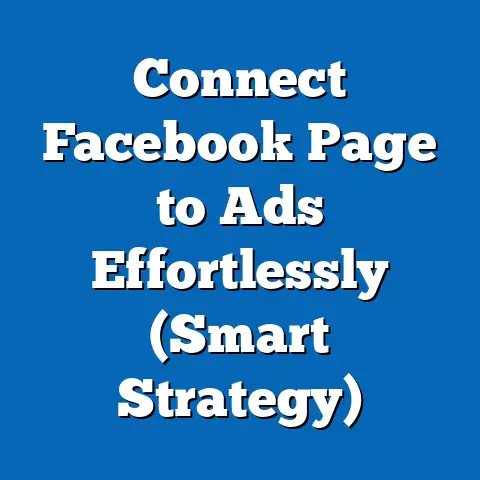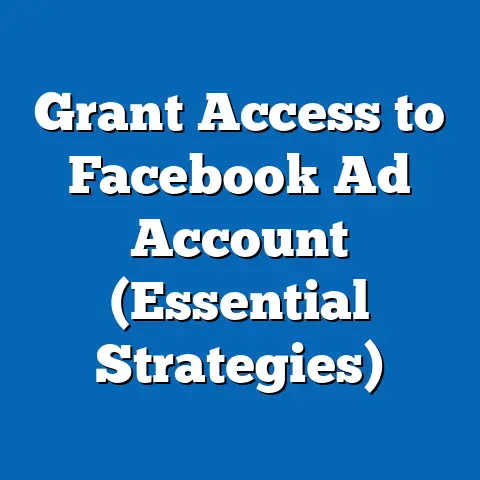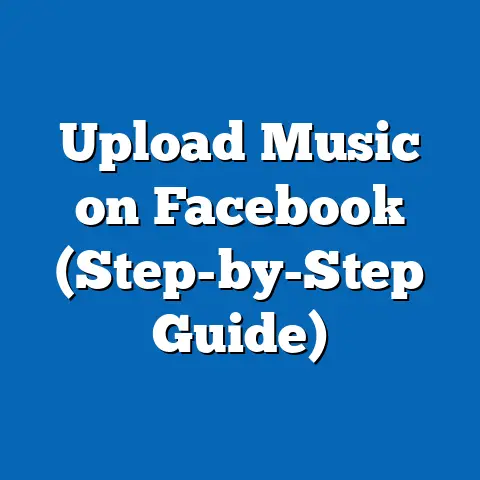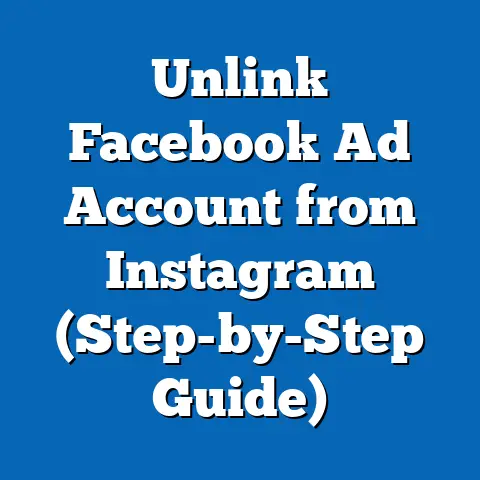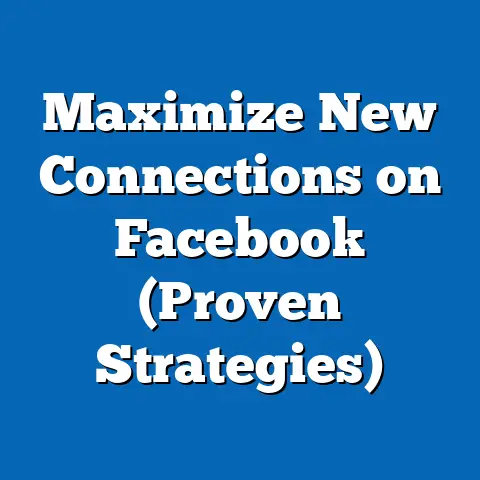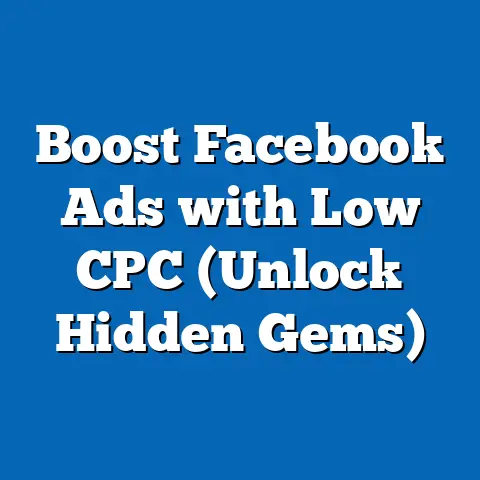What Happens When You Pause a Facebook Ad? (Expert Insights)
Facebook advertising has become a cornerstone of digital marketing. I see it everywhere, from small local businesses trying to get the word out, to massive corporations launching global campaigns. According to Statista, Facebook’s ad revenue reached a staggering $116.6 billion in 2023, highlighting the platform’s immense influence and reach. As advertisers, we’re constantly trying to find the magic formula for success, tweaking budgets, refining targeting, and experimenting with creative. But what happens when we hit that pause button? It seems like a simple act, but the implications can ripple through our campaigns in unexpected ways. Understanding these effects is crucial for optimizing our ad spend and achieving our marketing goals.
The Landscape of Facebook Advertising
Facebook, now Meta, is a behemoth in the digital advertising landscape. With billions of active users worldwide, it offers unparalleled reach and targeting capabilities. Over the years, I’ve watched it evolve from a simple social network to a sophisticated advertising platform, constantly adapting to user behavior and technological advancements.
Consider these statistics: as of the first quarter of 2024, Facebook boasts nearly 3.2 billion monthly active users. That’s a massive audience, representing a significant portion of the global population. This sheer scale makes Facebook an attractive platform for businesses of all sizes looking to connect with potential customers.
The platform also offers a diverse range of ad formats, from simple image ads to engaging video ads and interactive carousel ads. Each format serves a different purpose and caters to different marketing objectives. For example, I’ve found that video ads are particularly effective for brand awareness, while carousel ads are great for showcasing multiple products or services.
However, the competitive nature of Facebook advertising cannot be overstated. With millions of businesses vying for attention, standing out from the crowd requires a strategic approach and a deep understanding of the platform’s algorithms. As the competition intensifies, advertisers are under increasing pressure to optimize their campaigns and maximize their return on investment (ROI). This often involves making tough decisions, such as pausing underperforming ads or reallocating budgets to more promising strategies.
Key Takeaway: Facebook’s massive reach and diverse ad formats make it a powerful advertising platform, but its competitive landscape demands a strategic and data-driven approach.
The Mechanism of Facebook Ads
To truly understand the impact of pausing a Facebook ad, it’s essential to grasp the underlying mechanics of how the platform works. Facebook’s ad delivery system is a complex ecosystem driven by algorithms and auctions.
When you create an ad on Facebook, you’re essentially entering an auction. The platform uses a sophisticated algorithm to determine which ads to show to which users, based on factors such as your bid, the ad’s quality score, and the user’s likelihood of engaging with the ad. This algorithm is constantly learning and adapting, using data from billions of interactions to optimize ad delivery.
The targeting options on Facebook are incredibly granular. I’ve seen marketers target users based on demographics, interests, behaviors, and even life events. This level of precision allows you to reach highly specific audiences, increasing the likelihood of conversions.
Once an ad is live, it begins to accumulate impressions, reach, and engagement. Impressions refer to the number of times your ad is displayed, while reach refers to the number of unique users who have seen your ad. Engagement metrics, such as likes, comments, shares, and clicks, provide valuable insights into how users are interacting with your ad.
Key terms and metrics play a crucial role in understanding ad performance. CPM (Cost Per Mille) measures the cost of 1,000 impressions, while CTR (Click-Through Rate) measures the percentage of users who click on your ad after seeing it. CPC (Cost Per Click) measures the cost of each click on your ad. By tracking these metrics, you can identify areas for improvement and optimize your campaigns for better results.
Key Takeaway: Facebook’s ad delivery system is driven by algorithms and auctions, and understanding key metrics is crucial for optimizing ad performance.
Consequences of Pausing a Facebook Ad
Pausing a Facebook ad seems like a simple action, but it can have a range of consequences, both immediate and long-term. Let’s explore some of the most significant impacts:
-
Immediate Impacts:
- Data Loss: When you pause an ad, you may lose some of the data that the algorithm has accumulated about its performance. This can be particularly problematic if the ad was in the learning phase, as the algorithm may have to start from scratch when you reactivate it.
- Interruption in Ad Delivery: Pausing an ad immediately stops its delivery to your target audience. This can disrupt your marketing efforts and potentially lead to a loss of momentum.
- Changes in Audience Engagement: If your ad was generating significant engagement, pausing it can lead to a decline in audience interaction and potentially impact brand visibility.
-
Effects on the Learning Phase:
-
The learning phase is a critical period for new ads, during which the algorithm explores different delivery strategies to find the most effective approach. Pausing an ad during this phase can disrupt the learning process and potentially prolong the time it takes to optimize performance.
- I’ve personally experienced situations where pausing an ad in the learning phase resulted in a significant drop in performance when it was reactivated. In some cases, it was necessary to create a new ad altogether to achieve the desired results.
-
Pausing vs. Stopping:
-
It’s important to distinguish between pausing an ad and stopping it completely. Pausing an ad temporarily suspends its delivery, while stopping an ad permanently removes it from the system.
- Pausing is generally recommended for short-term adjustments or when you need to make minor changes to your ad. Stopping an ad is more appropriate when you want to retire it entirely or when it’s no longer relevant to your marketing goals.
Immediate Impacts:
- Data Loss: When you pause an ad, you may lose some of the data that the algorithm has accumulated about its performance. This can be particularly problematic if the ad was in the learning phase, as the algorithm may have to start from scratch when you reactivate it.
- Interruption in Ad Delivery: Pausing an ad immediately stops its delivery to your target audience. This can disrupt your marketing efforts and potentially lead to a loss of momentum.
- Changes in Audience Engagement: If your ad was generating significant engagement, pausing it can lead to a decline in audience interaction and potentially impact brand visibility.
-
Effects on the Learning Phase:
-
The learning phase is a critical period for new ads, during which the algorithm explores different delivery strategies to find the most effective approach. Pausing an ad during this phase can disrupt the learning process and potentially prolong the time it takes to optimize performance.
- I’ve personally experienced situations where pausing an ad in the learning phase resulted in a significant drop in performance when it was reactivated. In some cases, it was necessary to create a new ad altogether to achieve the desired results.
-
Pausing vs. Stopping:
-
It’s important to distinguish between pausing an ad and stopping it completely. Pausing an ad temporarily suspends its delivery, while stopping an ad permanently removes it from the system.
- Pausing is generally recommended for short-term adjustments or when you need to make minor changes to your ad. Stopping an ad is more appropriate when you want to retire it entirely or when it’s no longer relevant to your marketing goals.
Effects on the Learning Phase:
The learning phase is a critical period for new ads, during which the algorithm explores different delivery strategies to find the most effective approach. Pausing an ad during this phase can disrupt the learning process and potentially prolong the time it takes to optimize performance.
Pausing vs. Stopping:
It’s important to distinguish between pausing an ad and stopping it completely. Pausing an ad temporarily suspends its delivery, while stopping an ad permanently removes it from the system.
Key Takeaway: Pausing a Facebook ad can have immediate and long-term consequences, including data loss, interruption in ad delivery, and disruption of the learning phase. Understanding these impacts is crucial for making informed decisions about your ad strategy.
Expert Insights on Pausing Ads
To gain a deeper understanding of the nuances of pausing Facebook ads, I’ve gathered insights from industry experts, marketers, and Facebook advertising specialists. Here’s what they have to say:
“Pausing an ad is like hitting the brakes on a moving car,” says Sarah Jones, a seasoned digital marketing consultant. “You need to be aware of the potential consequences and have a good reason for doing it.”
According to Jones, there are several scenarios where pausing an ad may be beneficial:
- Seasonal Campaigns: Pausing ads that are specific to a particular season or event can help you avoid wasting budget on irrelevant traffic.
- Budget Constraints: If you’re running low on budget, pausing underperforming ads can help you reallocate funds to more promising strategies.
- Performance Dips: If an ad’s performance suddenly drops, pausing it can give you time to analyze the situation and make necessary adjustments.
However, experts caution against pausing ads too frequently or without a clear understanding of the potential consequences.
“The Facebook algorithm is constantly learning and adapting,” says David Lee, a Facebook advertising specialist. “Pausing an ad can disrupt this process and potentially set you back.”
Lee recommends closely monitoring ad performance and making gradual adjustments rather than abruptly pausing ads. He also suggests using A/B testing to compare different ad variations and identify the most effective strategies.
Case Studies:
- A local restaurant successfully paused its Facebook ads during a slow period, saving money and avoiding irrelevant traffic. When business picked up again, they reactivated the ads and saw an immediate increase in reservations.
- An e-commerce company paused its ads after experiencing a sudden drop in conversions. After analyzing the data, they discovered that a recent website update had broken the conversion tracking. Once the issue was resolved, they reactivated the ads and saw performance return to normal.
Key Takeaway: Pausing ads can be beneficial in certain scenarios, but it’s essential to understand the potential consequences and make informed decisions based on data and expert insights.
Long-Term Effects of Pausing Ads
The long-term effects of pausing ads can extend beyond immediate performance metrics and impact your overall marketing strategy. Let’s explore some of the key considerations:
- Brand Visibility: Pausing ads can lead to a decrease in brand visibility, particularly if you’re relying heavily on Facebook for your marketing efforts. Maintaining a consistent presence is crucial for building brand awareness and establishing trust with your target audience.
- Audience Retention: If you’re pausing ads frequently or for extended periods, you may risk losing touch with your audience. It’s important to keep your brand top-of-mind and continue engaging with your followers, even when you’re not actively running ads.
- Ad Fatigue: Ad fatigue occurs when your audience becomes tired of seeing the same ads repeatedly. Pausing ads can be a useful strategy for combating ad fatigue and refreshing your creative assets. By rotating your ads and introducing new messaging, you can keep your audience engaged and prevent them from tuning out your ads.
“Pausing ads can be a double-edged sword,” says Emily Chen, a marketing strategist. “On one hand, it can help you save money and avoid ad fatigue. On the other hand, it can negatively impact brand visibility and audience retention.”
Chen recommends developing a comprehensive ad strategy that takes into account both short-term performance metrics and long-term brand goals. She also suggests using a mix of ad formats and targeting options to keep your audience engaged and prevent ad fatigue.
Key Takeaway: Pausing ads can have long-term effects on brand visibility, audience retention, and ad fatigue. It’s important to develop a comprehensive ad strategy that balances short-term performance with long-term brand goals.
Conclusion
In conclusion, pausing a Facebook ad is not a decision to be taken lightly. While it can be a useful tool for managing budgets, addressing performance issues, and combating ad fatigue, it can also have significant consequences, including data loss, interruption in ad delivery, and disruption of the learning phase.
As the digital advertising landscape continues to evolve, it’s more important than ever for marketers to stay informed about platform dynamics and best practices. By understanding the mechanics of Facebook ads, the potential impacts of pausing them, and the insights of industry experts, you can make informed decisions that maximize your ROI and achieve your marketing goals.
I encourage you to analyze your own ad strategies and consider how your approach to pausing ads may impact your overall campaign goals. Experiment with different strategies, track your results, and continuously refine your approach based on data and insights.
Ultimately, success in Facebook advertising requires a combination of strategic thinking, data-driven decision-making, and a willingness to adapt to the ever-changing landscape. By mastering the art of pausing ads, you can take control of your campaigns and unlock the full potential of this powerful advertising platform. So, next time you’re tempted to hit that pause button, take a moment to consider the potential consequences and make sure it’s the right move for your business.

